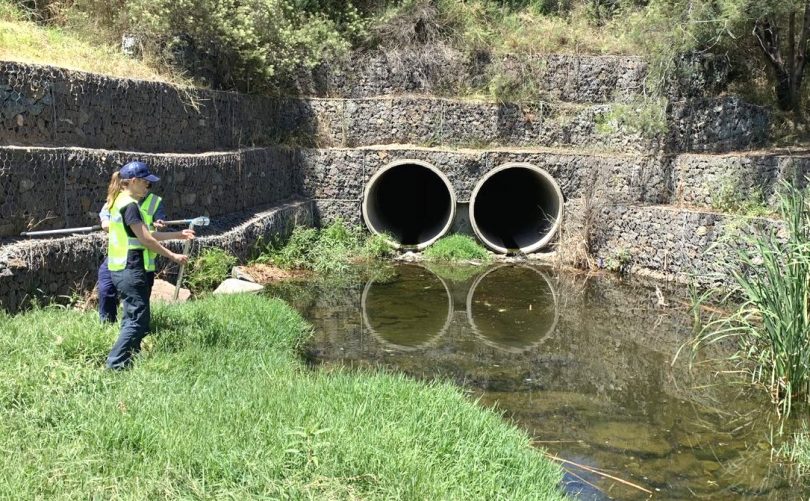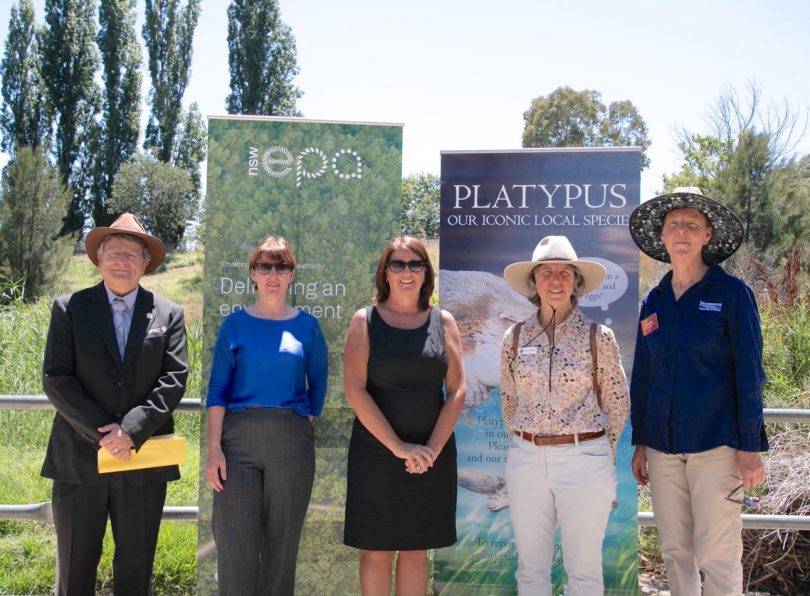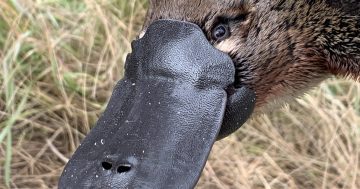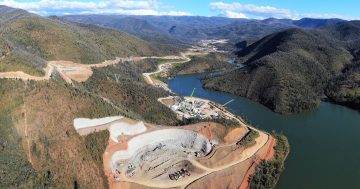
Representatives from the NSW EPA conduct water sampling at a spillway on the Molonglo River. Photo: Supplied.
Businesses in the Queanbeyan industrial area are urged to be more aware of harmful chemicals that have a toxic effect on the waterways of the nearby Molonglo and Queanbeyan Rivers.
The campaign targets industrial businesses to adopt best practice stormwater management. It follows a major solvent spill by waste management company Cleanaway in the adjacent Molonglo River in May 2020.
Members of the NSW Environment Protection Authority (EPA) met with businesses in the industrial estate along with local conservation groups and representatives from the Queanbeyan-Palerang Regional Council (QPRC).
NSW Environment Protection Authority CEO Tracy Mackey said each small action taken at industrial sites can directly impact water quality in the nearby Molonglo and Queanbeyan rivers, which flow into Canberra’s Lake Burley Griffin.
Ms Mackey urged Queanbeyan industrial businesses not to drain the health of local waterways which are home to important populations of fish, platypus, native rakali (water rats), birdlife and other creatures.
“The health of the waterways relies on everyone doing their bit to make a difference. Dirty and polluted stormwater and runoff from industrial areas can harm local animal populations and platypus habitat specifically.
“A little bit of pollution from each site can collectively have a big impact,” Ms Mackey said.
“Small changes by every business can make a difference and help to ensure our rivers are kept clean. The message is very simple – make sure only rain goes down your drain.”

QPRC portfolio General Manager Mike Thompson with NSW EPA CEO Tracy Mackey, Molonglo Conservation Group president Karen Williams and Deb Kellock and Carmen Dwyer of Molonglo Conservation Group and Upper Murrumbidgee Waterwatch. Photo: Supplied.
EPA and QPRC officers will focus on explaining best practice capture for chemical storage, the importance of dedicated washdown areas that don’t flow into stormwater drains and other tips on stopping the discharge of polluted runoff.
QPRC Mayor Tim Overall said the health of the catchment was important to all residents, with recent platypus surveys along the river attracting large numbers of community volunteers to help spot and count the often shy mammals. The council collects sightings of platypus and rakali as part of its citizen science monitoring and monitors catchment water quality closely.
Molonglo Conservation Group president Karen Williams said between Molonglo Gorge and Lake Burley Griffin, the Molonglo River has good water quality and is home to threatened species such as the Murray cod and platypus.
“It’s important that this part of the river is not overwhelmed by nutrient runoff, chemicals or rubbish that can come through in the stormwater from the adjacent urban and industrial areas,” Ms Williams said.
“Stormwater debris and nutrient runoff impacts on water quality by increasing algal blooms that reduce oxygen levels in the water. Chemical runoff can have disastrous impacts on aquatic species.”
Upper Murrumbidgee Waterwatch facilitator Woo O’Reilly said stopping pollution and litter reaching the waterways was also critical, as even small littered items like rubber bands and hair ties that wash down drains could have a deadly impact on the platypus population.
“They forage with their bills with their eyes closed and just don’t see this sort of litter which can get caught around them,” Ms O’Reilly said.
“Water bug populations are also a good indicator of water quality. Platypus eat a third of their body weight in water bugs each day, so keeping the waterways healthy is critical.”
More information on best practice stormwater management is available on the EPA website.
Original Article published by Michael Weaver on The RiotACT.








